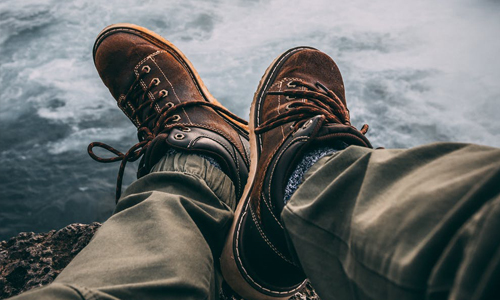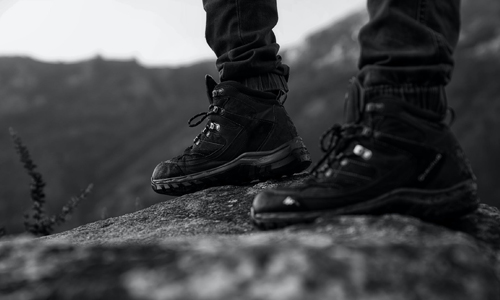Things to Consider before Buying Hiking Boots
Author

Chris shares his passion for cycling, hiking, skiing, and climbing from Buxton, in the Peak District. As a blogger for Outdoor Look, Chris shares outdoor tips and indoor tricks to help you get the most out of your time spent outside. When he's not out adventuring he's making videos or trying to keep up with his 4-year-old son.
It is imperative to consider all aspects of hiking boots before you buy a pair that suits you. This can help you gain more knowledge and save a lot of money that you have spent on the wrong stuff otherwise. General requirements that everyone considers includes comfort, weight, and resistance to water. However, there is much more to hiking boots that we will discuss here so you have a clear idea of what would be best for you.

Cut down the Confusion by Asking Necessary Questions
Being clear about what you want reduces effort and saves you a lot of time that can be utilized somewhere else. You can start off with asking yourself necessary questions:
- Which Type of Hiking Am I Going On?
- What is my budget?
- Where is the most suitable place where I will get the boots I need?
Types of Hiking Boots
For those who are new to hiking and are not aware of the different varieties in hiking boots, a thorough understanding is needed to choose the one that would keep you comfortable and safe. Majorly, there are 3 types of hiking boots:
- Lightweight Standard Hiking Boots: These are designed for hiking conditions with low-impact terrain that has pre-defined trails and gentles slopes. They are really lightweight and made using a combination of synthetic and leather materials for maximum breathability.
- Mid-weight Backpacking Boots: Designed for moderate inclines and uneven terrain, these are heavier than the standard hiking boots. Get them for long hikes as they have enough cushioning that can support your feet and ankle despite you carrying a moderately heavy backpack.
- Heavy Duty Mountaineering Boots: Such hiking boots are made for steep slopes and off-trail expeditions. The have excellent ankle support that allows you to carry heavy backpacks with supplies for multi-day hikes. The thick and stiff sole can handle the toughest terrain and is also available in crampon compatible option for those who want to go winter climbing.

Waterproof Hiking Boots
Hiking boots with a waterproof membrane prevent water from entering inside the footbed. Technologies like Gore-Tex make boots waterproof and suitable to be worn on trails where you have to wade across deep streams. These boots work perfectly when the water is below the ankle cuff and the membrane is perfectly fine.
What to Check When You Have Chosen the Right Boot?
There are a certain things that should not be missed before make the final call with the hiking boots you have chosen:
- Does it fit: Fitting is the most important thing. It decides whether the boot would keep you comfortable and safe on a rough terrain. It is recommended that you wear the same pair of socks you would wear while hiking to check the fitting. The most important thing is how they make you feel when you wear them. If they feel safe and comfortable, go ahead and make the final call.
- Type of Lacing: It you plan to put a lot of miles in your boots, then you should consider the ones that have flexible lacing mechanism. Different types of lacing can help relieve foot pain.
All these factors helps you choose the right boots for your hike. A good pair of boots majorly contribute to a safe and adventurous hiking experience where you do not have to worry about the terrain and the climate. Therefore, it is necessary for you to be very precise in choosing a pair.
Author

Chris shares his passion for cycling, hiking, skiing, and climbing from Buxton, in the Peak District. As a blogger for Outdoor Look, Chris shares outdoor tips and indoor tricks to help you get the most out of your time spent outside. When he's not out adventuring he's making videos or trying to keep up with his 4-year-old son.
- Speed Up Your Post-Hike Recovery with These 6 Essential Tips
- Cycling through Tranquil Roads and Coastal Views on the Isle of Wight
- The Essential Guide to Hiking Safety: 5 Tips Every Hiker Should Know
- Run Smart, Run Strong: Your Guide to Injury-Free Running
- Embrace Biking: Essential Tips for Beginners
Categories
- Sport (28)
- Product Reviews (3)
- Team Outdoor Look (7)
- Mike Wild (2)
- Mike Payton (2)
- Suse Hammond-Pears (3)
- Snowboarding (12)
- Latest Offers (105)
- Shop Talk (1)
- Competitions (7)
- Walking (413)
- Lifestyle Fashion (8)
- Travel (86)
- Kit Guides (176)
- Workwear Clothing (6)
- Safety Workwear (4)
- Health/Fitness (289)
- Skiing (91)
- Great Outdoors (1316)
- Cycling (92)
- January 2025
- December 2024
- November 2024
- October 2024
- September 2024
- August 2024
- July 2024
- June 2024
- May 2024
- April 2024
- March 2024
- February 2024
- January 2024
- December 2023
- November 2023
- October 2023
- September 2023
- August 2023
- July 2023
- June 2023
- May 2023
- April 2023
- March 2023
- February 2023
- January 2023
- December 2022
- November 2022
- October 2022
- September 2022
- August 2022
- July 2022
- June 2022
- May 2022
- April 2022
- March 2022
- February 2022
- January 2022
- December 2021
- November 2021
- October 2021
- September 2021
- August 2021
- July 2021
- June 2021
- May 2021
- April 2021
- March 2021
- February 2021
- January 2021
- December 2020
- November 2020
- October 2020
- September 2020
- August 2020
- July 2020
- June 2020
- May 2020
- April 2020
- March 2020
- February 2020
- January 2020
- December 2019
- November 2019
- October 2019
- September 2019
- August 2019
- July 2019
- June 2019
- May 2019
- April 2019
- March 2019
- February 2019
- January 2019
- December 2018
- November 2018
- October 2018
- September 2018
- August 2018
- July 2018
- June 2018
- May 2018
- April 2018
- March 2018
- February 2018
- January 2018
- December 2017
- November 2017
- October 2017
- September 2017
- August 2017
- July 2017
- June 2017
- May 2017
- April 2017
- March 2017
- February 2017
- January 2017
- December 2016
- November 2016
- October 2016
- September 2016
- August 2016
- July 2016
- June 2016
- May 2016
- April 2016
- March 2016
- February 2016
- January 2016
- December 2015
- November 2015
- October 2015
- September 2015
- August 2015
- July 2015
- June 2015
- May 2015
- April 2015
- March 2015
- February 2015
- January 2015
- December 2014
- November 2014
- October 2014
- September 2014
- August 2014
- July 2014
- June 2014
- May 2014
- April 2014
- March 2014
- February 2014
- January 2014
- December 2013
- November 2013
- October 2013
- September 2013
- August 2013
- July 2013
- June 2013
- May 2013
- April 2013
- March 2013
- February 2013
- January 2013
- December 2012
- November 2012
- October 2012
- September 2012
- August 2012
- July 2012
- June 2012
- May 2012
- April 2012
- March 2012
- February 2012
- January 2012
- December 2011
- November 2011
- October 2011
- September 2011
- August 2011
- May 2010
- April 2010
- March 2010
- February 2010
- January 2010
- November 2009
- October 2009
- September 2009
Submit a Comment